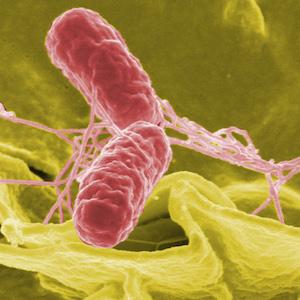Pest control and microbial disinfection protocols often utilize ultraviolet (UV) light. The reason is because UV light is extremely damaging to cells. Not only does it trigger the production of toxic compounds (such as reactive oxygen species), but it also causes weird structural changes in DNA (known as thymine dimers). The results are fatal.
UV light, however, is also dangerous to humans. So there is widespread interest in discovering light sources that can kill unwanted organisms while leaving humans unscathed. Farmers may be able to take advantage of the fact that fruit fly pupae are killed by blue light (wavelength = 467 nm), while public health officials should note that one species of mosquito is susceptible to violet light (wavelength = 417 nm).
These aren't the only "bugs" vulnerable to deadly visible light. Now, scientists from Singapore report in the journal Applied and Environmental Microbiology how violet light (wavelength = 405 nm) kills Salmonella in the refrigerator.
Causing about one million cases, Salmonella is the second most common source of domestically acquired foodborne illness in America, according to numbers from the CDC. Resulting in nearly 20,000 hospitalizations and roughly 400 deaths every year, the reduction of Salmonella in our food supply would save both lives and healthcare costs*.
 From a distance of 4.5 cm (1.8 in.), the researchers shined violet LED bulbs on 18 different strains of Salmonella growing on Petri plates. As shown in the image on the right, some were nearly wiped out, while other strains managed to survive well enough. All of them, however, grew much less than they did when no violet light was shined on them.
From a distance of 4.5 cm (1.8 in.), the researchers shined violet LED bulbs on 18 different strains of Salmonella growing on Petri plates. As shown in the image on the right, some were nearly wiped out, while other strains managed to survive well enough. All of them, however, grew much less than they did when no violet light was shined on them.
The team then selected the single most light-sensitive and single most light-resistant strains for further analysis. Their experiments revealed that both strains were extensively injured by the 405 nm light. DNA was damaged, efflux pumps were inhibited, and glucose uptake was reduced. So why was one strain likelier to survive such an assault, while the other one died?
Subsequent analysis indicated that the cold temperature of the refrigerator and/or starvation conditions activated genes that help the hardier bacterium survive during times of stress; the frail bacterium didn't activate all of these genes. Essentially, inherent genetic differences may explain why some strains of Salmonella survive what other strains would find to be a lethal dose of violet light.
The team says that previous research it conducted showed that visible light of 405 nm (violet) and 460 nm (blue) can also kill Bacillus cereus, E. coli O157:H7, Listeria monocytogenes, Shigella sonnei, and Staphylococcus aureus, all of which cause food poisoning.
The present study has a few limitations. First, the researchers didn't examine how 405 nm light would work against Salmonella present in food samples, such as chicken. Second, they didn't determine how many light bulbs would need to be in a refrigerator in order to substantially reduce Salmonella contamination.
Still, if meat processing equipment and home refrigerators came equipped with little blue and violet lights, perhaps fewer of us would end up sick or in the hospital.
*Note: Worldwide, the numbers are much worse: Salmonella is blamed for 94 million infections and 155,000 deaths.
Source: Min-Jeong Kim and Hyun-Gyun Yuk. "Antibacterial Mechanism of 405-Nanometer Light-Emitting Diode against Salmonella at Refrigeration Temperature." Appl. Environ. Microbiol. vol. 83 no. 5 e02582-16. Published: March 2017. doi: 10.1128/AEM.02582-16




